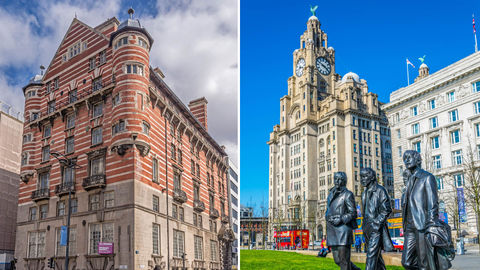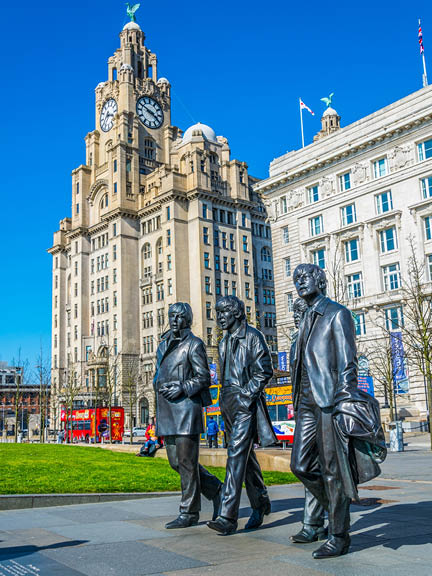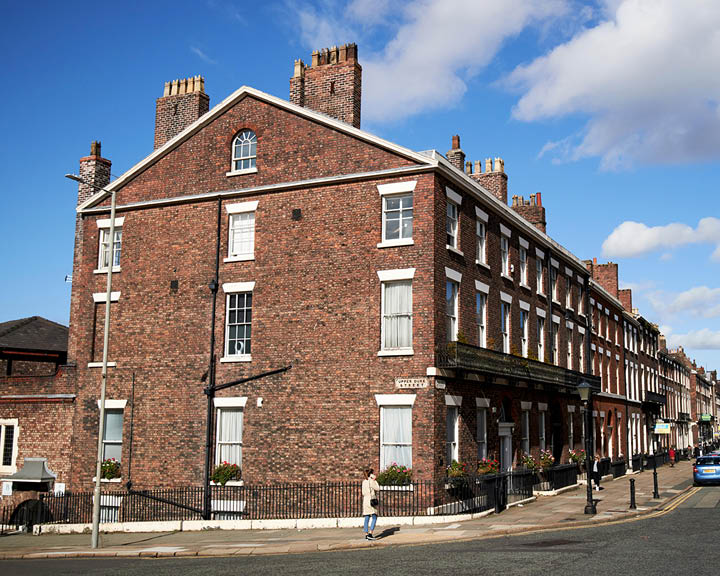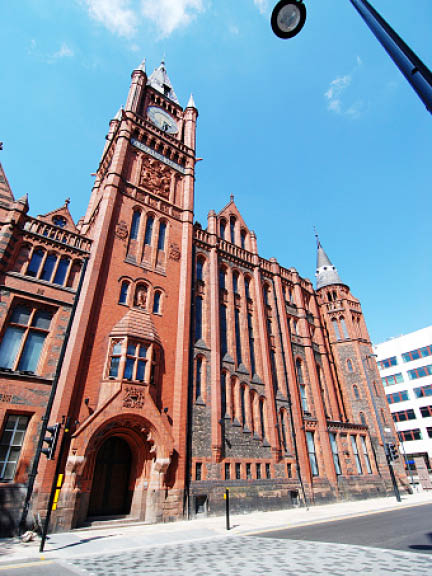
On a freewheeling walk through Liverpool, Kalpana Sunder discovers architectural marvels and priceless pieces of history repurposed into contemporary social hubs. By Kalpana Sunder

I am in Liverpool, a city that most people know for its music and football. Few realise that it’s also an architecturally stunning city, with the most number of UNESCO-listed buildings in the United Kingdom outside London. For decades, it was a prosperous port city, where ships brought in tobacco, silk, and sugar. Shipping and insurance companies built grandiose offices, and iconic civic buildings like the Liverpool Town Hall came up. In fact, Liverpool has been called England’s first Victorian city.

In 2004, large parts of the mercantile port city were declared a UNESCO World Heritage Site. Today, Liverpool has as many as 2,500 listed buildings, and around 27 of them are Grade 1. Over the last few years, the town has undergone a renaissance as a cultural centre; warehouses and old buildings have been spruced up and converted into museums, galleries, or restaurants. My address, Titanic Hotel Liverpool, was a tobacco warehouse in the 19th century; today, it’s a stylish hotel with high ceilings and exposed brickwork—draped in a nautical theme.

Coming out of the Liverpool Lime Street railway station, my eyes are first drawn to the magnificent St George’s Hall, which used to house law courts and is now used for concerts, receptions, and lectures. Queen Victoria once declared that the “building was worthy of ancient Greece.” This was where Charles Dickens gave public readings of his books. With Corinthian columns, 30,000 Minton tiles on the floor, and bronze doors, this Neo-Classical building dates back to 1854 and was one of the first public buildings in the UK to be fitted with air conditioning. The space in front of the building has been used over the years for public rallies and meetings.

On the riverfront are the iconic Three Graces: a set of three buildings that count among the town’s most beautiful and stately ones and have defined the city’s skyline down the ages. They include the Royal Liver Building, the Cunard Building, and the Port of Liverpool building, an Edwardian baroque beauty with a large dome. I take a guided tour of the Royal Liver Building, built with granite and reinforced concrete, and endowed with a clock-face (7.6 metres in diameter) larger than that on London’s Big Ben. When it was built in 1911,
it was UK’s first skyscraper. The building is perfectly symmetrical on all sides, with Byzantine and baroque influences. The digital show inside the clock-face is a journey back in time—into Liverpool’s history.

The Royal Albert Dock, near Mersey Ferry, is the largest collection of heritage buildings in the city. The complex of dock buildings and warehouses dates back to 1846 when it was built from cast iron, brick, and stone—with no wood at all. As many as 23 million bricks went into building this gargantuan complex with stocky iron columns. Valuable cargo like tobacco, sugar, and silk used to be stored in these warehouses, and ships could load or unload directly from these warehouses. After being in a derelict state for many years, it was re-opened in 1984, with many of the warehouses converted into museums, luxury apartments, restaurants, and cafes.
Liverpool had the country’s first schools of art and architecture—as far back as 1893. The buildings of the city were some of the earliest fire-proofed structures, and many were avant-garde designs, ahead of their times, like the Oriel Chambers, which featured the world’s first metal-framed glass curtain wall that allowed light in. Designed by architect Peter Ellis in 1864, this was the precursor of the skyscraper. Today, the city has a mix
of architectural styles: from Queen Anne style to Neo-Classical and Georgian.

Bookending the two sides of the aptly-named Hope Street, the Liverpool Anglican Cathedral and Metropolitan Cathedral of Christ the King are vastly different in architecture, but both are striking in their own ways. The Neo-Gothic Anglican Cathedral, designed by Sir Giles Gilbert, was built from pinkish-red sandstone over 74 years and is the longest cathedral in the world. It has the world’s highest and heaviest set of bells called the Great George, and the church is used for hosting conferences, exhibitions, graduations, etc. The Metropolitan Cathedral of Christ, on the other hand, is a modern circular cathedral with exquisite stained-glass windows, built over an unfinished Romanesque cathedral.
Another listed building that I love is the Victoria Building, a part of the Liverpool University that inspired the term ‘red brick university’. Under the brickwork, the building has a fireproof structure of iron and concrete. With oriel windows, buttresses, arches, and spires, as well as Italian mosaic floors, this structure is used as a gallery and museum.

My favourite building though is the Picton Reading Room at the Liverpool Central Library. Modelled after the British Library’s rotunda, it was designed by Cornelius Sherlock, with a domed roof, an oculus, wrought-iron staircases, and bookshelves. The modern side of the library comes with sweeping floors and a glass dome with an atrium. It’s the perfect marriage of old and new.
On the corner of James Street is Albion House, with its turrets and gables. One of the city’s most striking buildings, the 1898 structure has been dubbed by the locals as the ‘streaky bacon’ building. Albion House infamously used to be the office of the White Star Line shipping company (the registered home of the ill-fated Titanic). This eight-storey building, with its façade made from white Portland stone and red brick in alternate bands, is the place from where the sinking of the Titanic was announced. Today it’s a Titanic-themed hotel called 30 James Street, with its bar named after Carpathia, the vessel that rescued the survivors of the tragedy.

Walking down Rodney Street in the Georgian quarter of the city, it’s love at first sight for me. The area harks back to an elegant time in history when the city’s elites, who had made their money from mercantile trade, wanted to showcase their wealth. Rows of Georgian townhouses line the street with their distinctive façades and coloured doors. Today, the street is a favourite of production crews—most recently, it featured on the series Peaky Blinders.
In Liverpool, urban renewal is in the air. The Everyman Theatre was once a 19th-century chapel, which became a public concert hall and finally a cinema theatre until it closed down in 2011. It was completely rebuilt and opened in 2014 using the recycled bricks and timber from the original structure. Today, this award-winning building has a brick façade with 105 movable metal sunshades, each carrying a life-sized portrait of a contemporary city resident.

I have lunch at Leaf on Bold Street, a tea shop and bar with antique sofas and fairy lights. It is housed in an Art Deco building that used to be a cinema in the late 20th century. The Baltic Triangle is a neighbourhood where industrial warehouses and brick buildings are now hubs of creativity: radio stations, tech startups, cafes, vintage markets, and restaurants.
Before I leave the city, I chance upon one last extraordinary building; the Church of St Luke also called the ‘bombed out church’. It’s a fragile shell, a skeletal shadow of a grand church with buttresses and pinnacles dating back to 1832 that was bombed by the Germans in 1941. Today, this roofless structure stands as a testimony, and memorial, to those who died in World War II, and hosts exhibitions, events, and concerts. It’s entirely appropriate that in a city of beautiful buildings, even an architectural shell is preserved and serves a noble purpose.
GETTING THERE
Fly Etihad Airways to Manchester from Delhi or Mumbai, and connect by train to Liverpool. It’s a 40-minute ride.
STAY
The Titanic Hotel Liverpool is an old warehouse in Stanley Docks, with Victorian architecture, transformed into a luxury hotel with a restaurant and spa. Doubles from INR 17,000 per night.
The Hard Days Night Hotel is a Beatles-themed hotel housed in a historic building, in the centre of town. From INR 7,500 per night.
TOURS
RIBA Liverpool City Tours conducts two-hour-long tours of different parts of the city and their buildings and spaces.
Related: 7 Natural Wonders Of The World From The POV Of An Architect










